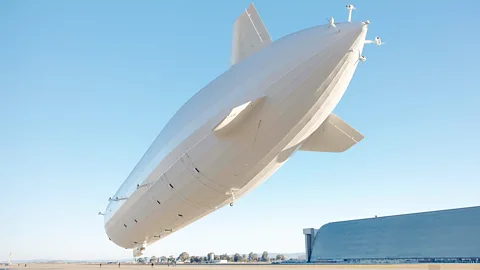
Pathfinder 1, funded by a Google billionaire, aims to bring back the airship. A century after some frightening disasters, is it a safe enough gamble?
On October 24, 2024, a short post appeared on the social media platform LinkedIn. In it, Google co-founder Sergey Brin's airship company, LTA Research, announced Pathfinder 1's first, albeit brief, untethered flight at NASA's Moffett Field in California, part of the space agency's Ames Research Center. "This morning, Pathfinder 1 reached another milestone: untethered outdoor flight. This successful test marks another important step in our journey, and we are excited to build on this achievement through our rigorous testing program."
Airships are hard to hide. Despite the secrecy, a YouTuber filmed it from the road and uploaded the video online.
"Pathfinder 1 is a pretty amazing vehicle," says Alan Shrimpton, editor of the Airship Journal. "It's the first fully rigid airship of this size in a very long time, and there was a lot of anticipation that it would fly soon after starting its outdoor testing program.
"But Alan Weston [founder and former CEO of LTA Research] always said the biggest problem with rigid airships in the past was that people rushed their development. They were determined not to repeat that mistake. They checked everything thoroughly, and they did." The understated tone in LTA's postThe understated tone in LTA's post hides the historic achievements of Brin's company so far. This was the first flight of the first airship built by the Google cofounder's company, marking the first time a classic rigid airship of this size had flown since the 1930s, and the beginning of a new generation of airships. The last giant rigid airship, Graf Zeppelin II, flew for the last time on August 20, 1939, just 12 days before World War Two began, and was dismantled the following year. Rigid airships have a complex metal framework that supports a large envelope filled with enough hydrogen or helium to lift a significant number of passengers or cargo, such as disaster relief supplies, for days at a time.
Hydrogen-filled airships are also symbols of the Golden Age of airships, the era between the world wars when the technology's promoters captivated the public with promises of scheduled commercial passenger services between places like Europe and North America, and North America and the Pacific. In some cases, they delivered on these promises. The Graf Zeppelin offered "the first regularly scheduled, nonstop, intercontinental airline service in the history of the world" between Germany and South America, and it was much faster than the ocean liners that traveled the same route.
But the crash of the airship Hindenburg in 1937, which killed 36 people, including one person on the ground, highlighted the dangers of using flammable gas for buoyancy. The airship then faded into obscurity as conventional aircraft design advanced.
Eighty-six years later, in November 2023, Pathfinder 1 emerged for the first time from the historic Hangar Two at Moffett Field to begin its outdoor flight-testing program. However, the world's largest aircraft remained firmly tethered to the ground, much to the frustration of many aviation enthusiasts. Its anticipated first flight did not occur.
Thanks to the Google co-founder's substantial resources, LTA Research seems to have the freedom to take their time and get it right, a luxury not always afforded to others.
They have used this freedom to find better materials than lightweight aluminum alloys like duralumin for constructing the giant frame of a rigid airship. They have also explored using cotton-composite materials and even cow guts for the envelope, gaining a much better understanding of the aerodynamics involved in flying very large airships. It seems they have been able to carefully test their creation without the overconfidence and pressure from investors that have been issues in the past.
